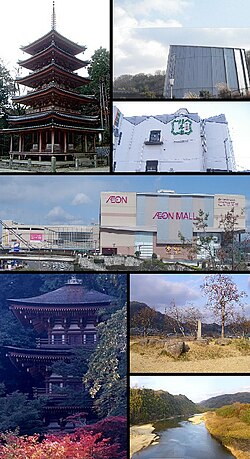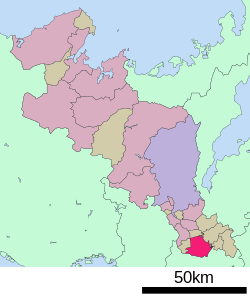world.wikisort.org - Japan
Kizugawa (木津川市, Kizugawa-shi) is a city located in southern Kyoto Prefecture, Japan.[1] It is the southernmost city in the prefecture and it is named after the Kizu River, a tributary of the Yodo River, which runs through the city. Kizugawa City is a part of the Kansai Science City project and houses research facilities of several corporations, including Rohto Pharmaceutical and Omron. As of 1 September 2022[update] the city has an estimated population of 79,171.[2]
Kizugawa
木津川市 | |
|---|---|
City | |
 From upper left, clockwise: Kaijyūsen-ji, The Kids' Science Museum of Photons, Fukujyuen Cha Research Center, Æon Mall Takanohara, Kuni-kyō Ruins, Kizu River | |
 Flag  Emblem | |
 Location of Kizugawa in Kyoto Prefecture | |
 Kizugawa Location in Japan | |
| Coordinates: 34°44′N 135°49′E | |
| Country | Japan |
| Region | Kansai |
| Prefecture | Kyoto Prefecture |
| First official recorded | 3rd century AD |
| City Settled | March 12, 2007 |
| Government | |
| • Mayor | Noriko Kawai |
| Area | |
| • Total | 85.13 km2 (32.87 sq mi) |
| Population (September 1, 2022) | |
| • Total | 79,171 |
| • Density | 930/km2 (2,400/sq mi) |
| Time zone | UTC+09:00 (JST) |
| City hall address | Kizu Minami-gaito 110-9, Kizugawa City, Kyoto Prefecture (京都府木津川市木津南垣外110-9) 619-0286 |
| Website | www |
| Symbols | |
| Flower | Cosmos |
| Tree | Cherry blossom |
Kizugawa City is one of the few municipalities in Japan with a growing population. In a population estimate released by the Japan Policy Council, Kizugawa City is the only municipality in Kyoto Prefecture predicted to have a positive population growth rate by 2040.
History
The modern city was established on March 12, 2007, from the merger of the towns of Kamo, Kizu and Yamashiro (all from Sōraku District).
In the Nara period, Emperor Shōmu moved the capital from Heijō-kyō to Kuni-kyō, which was located on Kizugawa City's ground. Kuni-kyō served as the capital for 5 years from 740 to 744. Its ruins can be found in Kamo area. Now, Kizugawa City is a part of the national Kansai Science City project.
Geography

Kizugawa City is located on the southern border of Kyoto Prefecture. The Kizu River, from which the city inherits its name, runs through the city.
Demographics
Per Japanese census data,[3] the population of Kizugawa has grown in recent decades.
| Year | Pop. | ±% |
|---|---|---|
| 2000 | 58,809 | — |
| 2010 | 69,761 | +18.6% |
| 2020 | 77,907 | +11.7% |
Business
Kansai Science City and Enterprises
Being a part of the Kansai Science City project, Kizugawa City houses over 20 enterprises and research facilities including:
- Rohto Pharmaceutical (ロート製薬)
- Omron (オムロン)
- Sekisui House (積水ハウス)
- Fukujyuen (福寿園)
- Ataka Daiki Engineering (アタカ大機)
- Tatsuta Electric Wire Cable Co. (タツタ電線)
- M-system (エム・システム)
- Manyo Tools (マンヨーツール)
- Mizuho Co. (株式会社ミズホ)
- Solno Leaves Co. (ソルノリーブス)
- Kyoto Press Industrial Co. (京都プレス工業)
Also, Doshisha University Gakkentoshi Campus(学研都市キャンパス), which focuses on graduate studies in biomedicine, and Doshisha International School, Kyoto (DISK) are also located in Kizugawa City.
Other public and private research organizations in Kizugawa City include:
- International Institute for Advanced Studies (IIAS, 国際高等研究所)
- Research Institute of Innovative Technology for the Earth (RITE, 地球環境産業技術研究機構)
- Japan Atomic Energy Agency Kansai Photochemistry Research Center (日本原子力研究開発機構 関西光化学研究所)
Transportation
Kizugawa City serves as a commuter town for Osaka City, Kyoto City, and Nara City. Osaka City and Kyoto City are both within an hour by car or train, and Nara City is reachable in 15 minutes. Kizugawa city currently have JR and Kintetsu railways running through the city and a growing community bus system.
Rail
Kizugawa City is a key stop in railway system in Kansai. The JR Nara Line, Gakkentoshi Line, and Kansai Main Line converge at Kizu Station. Also in the west part of the city runs Kintetsu Kyoto Line.
Bus
Kizugawa City Community Bus (木津川市コミュニティバス) and Nara Kotsu Bus (奈良交通バス) run in Kizugawa City.
All Kizugawa City Community Bus buses, excluding Tono Line (当尾線), have a fixed fare. Kizugawa City Community Bus 1-Day Tickets are available at the city hall, branch offices, and on Kizugawa City Community Buses. They are useful for residents and visitors for traveling to several locations in the city.
Tourism
Kizugawa City is the home of several famous temples including:
- Jōruri-ji (浄瑠璃寺): Main Hall, main Buddha image, and 3-story pagoda listed as National Treasures
- Kaijyusen-ji (海住山寺): 5-story pagoda listed as a National Treasure
- Gansen-ji (岩船寺): 3-story pagoda listed as an Important Cultural Property
- Kaniman-ji (蟹満寺): main Buddha image listed as a National Treasure
Other attractions include:
- Kuni-kyō Ruins
- The Kids' Science Museum of Photons (きっづ光科学館ふぉとん)
- Yamashiro Local History Museum (ふるさとミュージアム山城)
- Tono Stone Buddha Path(当尾石仏の里)
Education
Postsecondary
- Doshisha University, Gakkentoshi Campus
High schools
- Nanyō High School
- Kizu High School
Junior high schools
- Kizu Junior High School
- Kizu Daini Junior High School
- Kizu Minami Junior High School
- Izumigawa Junior High School
- Yamashiro Junior High School
Elementary schools
- Kizu Elementary School
- Saganaka Elementary School
- Takanohara Elementary School
- Kizugawadai Elementary School
- Saganakadai Elementary School
- Umemidai Elementary School
- Kunimidai Elementary School
- Shiroyamadai Elementary School
- Kamo Elementary School
- Kuni Elementary School
- Minami Kamodai Elementary School
- Kamikoma Elementary School
- Tanakura Elementary School
- Doshisha International Academy Elementary School
Friendship cities
 Kyōtango, Kyoto (since Jan 11, 2008)
Kyōtango, Kyoto (since Jan 11, 2008) Santa Monica, California, U.S.A. (since 2017)
Santa Monica, California, U.S.A. (since 2017)
Notable people
- Yui Yokoyama, ex-member of AKB48
- Hiroyasu Tanaka, Central League baseball player
References
- "木津川市観光サイト|お茶の京都|京都府南部(山城地域)の観光情報". ochanokyoto.jp (in Japanese). Retrieved 2022-10-21.
- "Official website of Kyoto Prefecture" (in Japanese). Japan: Kyoto Prefecture. Retrieved October 19, 2022.
- Kizugawa population statistics
External links
 Media related to Kizugawa, Kyoto at Wikimedia Commons
Media related to Kizugawa, Kyoto at Wikimedia Commons- Kizugawa City official website
- Kizugawa City official website (in Japanese)
- Kizugawa City Living Guide
На других языках
[de] Kizugawa
Kizugawa (japanisch 木津川市, -shi) ist eine japanische Stadt im Süden der Präfektur Kyōto.- [en] Kizugawa, Kyoto
[ru] Кидзугава
Кидзугава (яп. 木津川市 Кидзугава-си) — город в Японии, находящийся в префектуре Киото. Площадь города составляет 85,13 км²[1], население — 77 960 человек (1 октября 2020)[2], плотность населения — 915,78 чел./км².Другой контент может иметь иную лицензию. Перед использованием материалов сайта WikiSort.org внимательно изучите правила лицензирования конкретных элементов наполнения сайта.
WikiSort.org - проект по пересортировке и дополнению контента Википедии